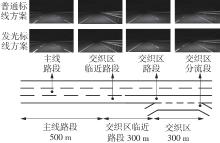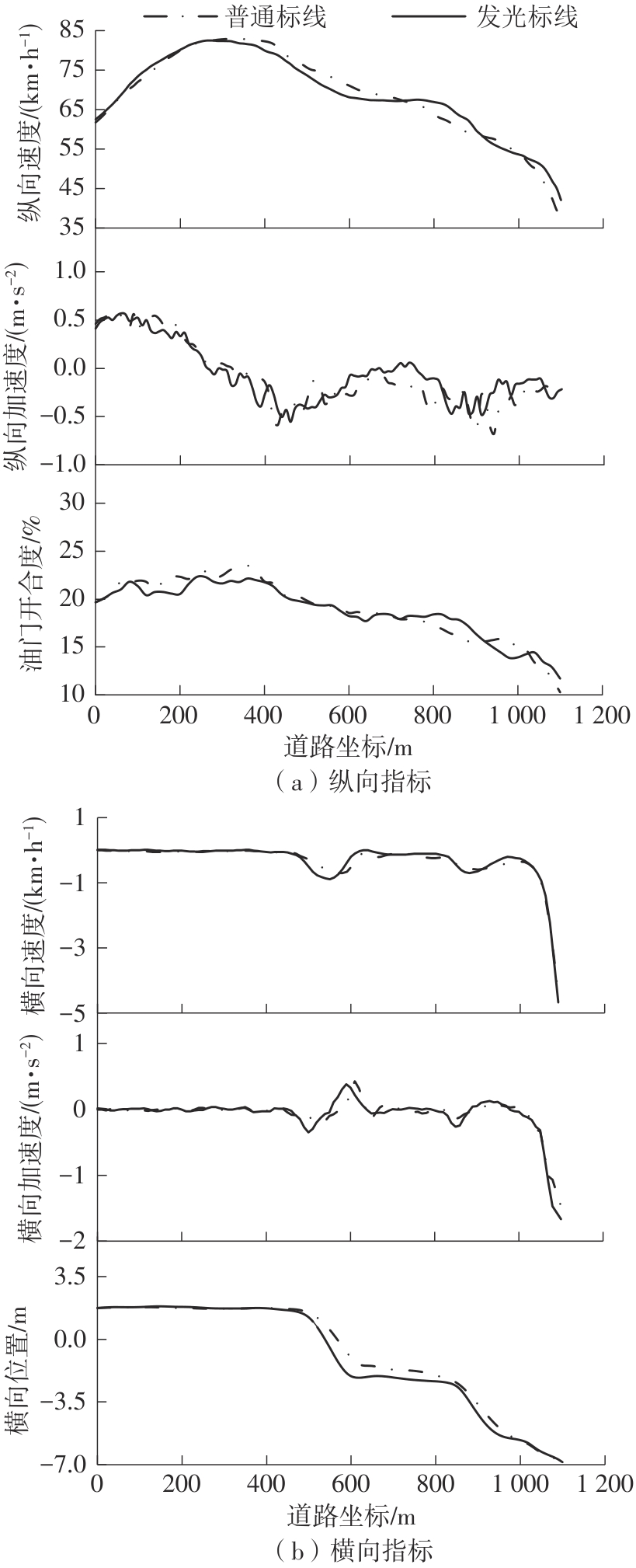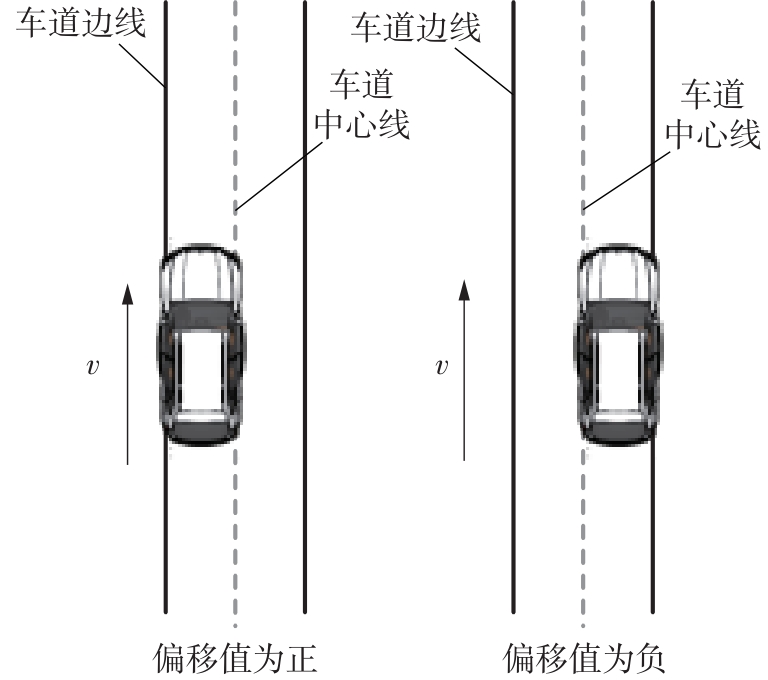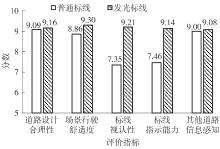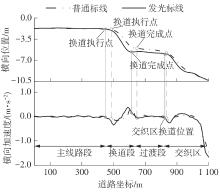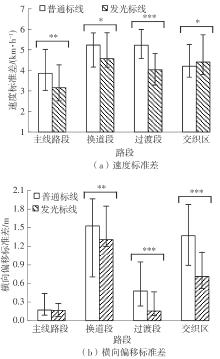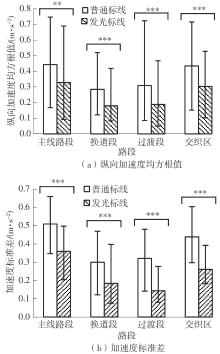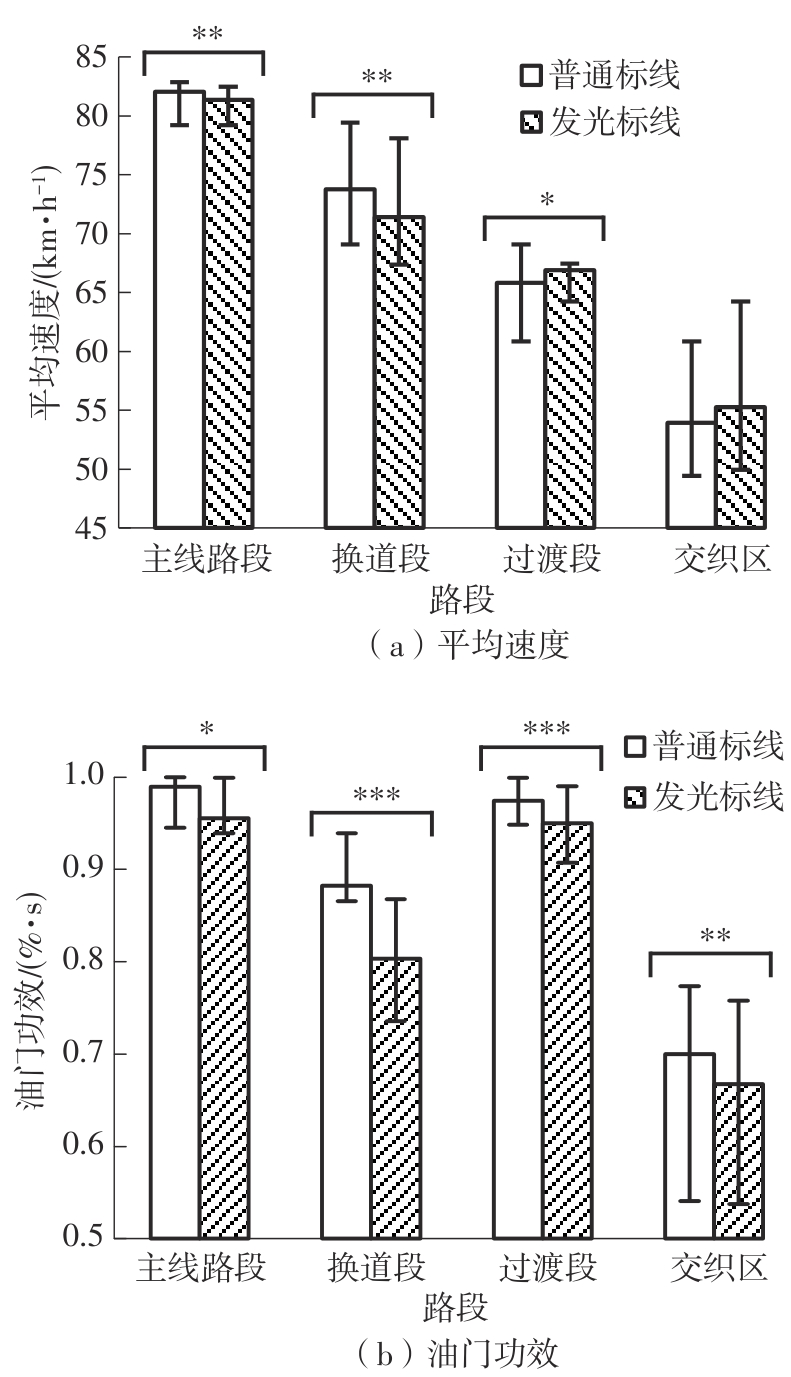Journal of South China University of Technology(Natural Science Edition) ›› 2024, Vol. 52 ›› Issue (11): 106-117.doi: 10.12141/j.issn.1000-565X.230762
Special Issue: 2024年智慧交通系统
• Intelligent Transportation System • Previous Articles Next Articles
Evaluation of the Effect of Self-Luminous Road Marking in Expressway Weaving Section Based on Driving Behavior
ZHANG Ting1( ), CHEN Feng1(
), CHEN Feng1( ), LI Huang1,2, CHEN Jilong1, YOU Kesi3
), LI Huang1,2, CHEN Jilong1, YOU Kesi3
- 1.The Key Laboratory of Road Traffic Engineer of Ministry of Education,Tongji University,Shanghai 201804,China
2.China Railway Guangzhou Group Co. ,Ltd. ,Guangzhou 510088,Guangdong,China
3.Shanghai Municipal Engineering Design Institute (Group) Co. ,Ltd. ,Shanghai 200092,China
-
Received:2023-12-08Online:2024-11-25Published:2024-04-30 -
Contact:陈丰(1982—),男,教授,博士生导师,主要从事交通安全、风工程等研究。 E-mail:fengchen@tongji.edu.cn -
About author:张婷(1994—),女,博士生,主要从事交通安全研究。E-mail:ztingyo@tongji.edu.cn -
Supported by:the National Natural Science Foundation of China(51978522);the Shanghai 2021“Science and Technology Innovation Action Plan”Yangtze River Delta Science and Technology Innovation Community Program in China(21002410700)
CLC Number:
Cite this article
ZHANG Ting, CHEN Feng, LI Huang, et al. Evaluation of the Effect of Self-Luminous Road Marking in Expressway Weaving Section Based on Driving Behavior[J]. Journal of South China University of Technology(Natural Science Edition), 2024, 52(11): 106-117.
share this article
Table 2
Calculation results of indicators significance and effect size"
| 路段 | 速度标准差 | 横向偏移标准差 | 纵向加速度均方根值 | ||||||
|---|---|---|---|---|---|---|---|---|---|
| F | P | F | P | F | P | ||||
| 主线路段 | 5.362 | 0.025** | 0.109 | 0.448 | 0.533 | 0.008 | 11.199 | 0.001** | 0.162 |
| 换道段 | 3.858 | 0.056* | 0.084 | 4.629 | 0.035** | 0.076 | 27.452 | < 0.001*** | 0.321 |
| 过渡段 | 20.442 | < 0.001*** | 0.338 | 20.646 | < 0.001*** | 0.421 | 16.277 | < 0.001*** | 0.219 |
| 交织区 | 4.821 | 0.053* | 0.325 | 24.841 | < 0.001*** | 0.495 | 20.750 | < 0.001*** | 0.263 |
| 路段 | 加速度标准差 | 平均速度 | 油门功效 | ||||||
| F | P | F | P | F | P | ||||
| 主线路段 | 35.289 | < 0.001*** | 0.597 | 4.892 | 0.032** | 0.096 | 2.598 | 0.091* | 0.091 |
| 换道段 | 39.274 | < 0.001*** | 0.404 | 5.480 | 0.024** | 0.115 | 16.632 | < 0.001*** | 0.431 |
| 过渡段 | 37.876 | < 0.001*** | 0.704 | 3.052 | 0.088* | 0.071 | 21.944 | < 0.001*** | 0.458 |
| 交织区 | 39.774 | < 0.001*** | 0.707 | 1.725 | 0.398 | 0.015 | 5.291 | 0.034** | 0.227 |
Table 5
Comprehensive correlation degree and evaluation grade of each road marking scheme"
| 等级 | 主线路段 | 换道段 | 过渡段 | 交织区 | ||||
|---|---|---|---|---|---|---|---|---|
| 普通 标线 | 发光 标线 | 普通 标线 | 发光 标线 | 普通 标线 | 发光 标线 | 普通 标线 | 发光 标线 | |
| 优 | -0.443 | -0.288 | -0.368 | -0.375 | -0.347 | 0.102 | -0.402 | -0.281 |
| 良好 | -0.233 | 0.210 | -0.014 | 0.017 | -0.181 | -0.101 | -0.094 | 0.132 |
| 中等 | 0.280 | -0.245 | 0.108 | -0.001 | 0.242 | -0.431 | 0.148 | -0.239 |
| 较差 | -0.102 | -0.528 | -0.286 | -0.381 | -0.167 | -0.662 | -0.219 | -0.559 |
| 差 | -0.375 | -0.644 | -0.472 | -0.545 | -0.388 | -0.751 | -0.423 | -0.674 |
| 1 | WANG L, ABDEL-ATY M, SHI Q,et al .Real-time crash prediction for expressway weaving segments[J].Transportation Research Part C:Emerging Technologies,2015,61(12):1-10. |
| 2 | 张菁,巨永锋 .快速路交织区交通流模型研究[J].中国公路学报,2011,24(5):89-93. |
| ZHANG Jing, JU Yong-feng .Research on traffic flow model of expressway weaving area[J].China Journal of Highway and Transport,2011,24(5):89-93. | |
| 3 | 江金胜,董力耘 .基于元胞自动机模型的C型交织区交通流特性[J].力学学报,2012,44(6):996-1004. |
| JIANG Jinsheng, DONG Liyun .Investigation on traffic flow characteristics around a type C weaving section based on cellular automaton model[J].Chinese Journal of Theoretical and Applied Mechanics,2012,44(6):996-1004. | |
| 4 | 孙剑,胡家琦,孙杰 .城市快速路交织区通行能力估计模型[J].中国公路学报,2016,29(4):114-122. |
| SUN Jian, HU Jia-qi, SUN Jie .Capacity estimation model on weaving segments of urban expressway[J].China Journal of Highway and Transport,2016,29(4):114-122. | |
| 5 | MARCZAK F, DAAMEN W, BUISSON C .Empirical analysis of lane changing behavior at a freeway weaving section[J].Traffic Management,2016,3(10):139-151. |
| 6 | 张卫华,刘嘉茗,解立鹏,等 .混合网联环境快速路交织区交通流特性分析[J].东南大学学报(自然科学版),2023,53(1):156-164. |
| ZHANG Weihua, LIU Jiaming, XIE Lipeng,et al .Analysis on the characteristics of traffic flow in expressway weaving area under mixed connected and autonomous environment[J].Journal of Southeast University (Natural Science Edition),2023,53(1):156-164. | |
| 7 | SOLOMON D H .Accidents on main rural highways related to speed,driver,and vehicle[M].Washington D.C.:US Department of Transportation,Federal Highway Administration,1974. |
| 8 | ZHANG J, LEE J, ABDEL-ATY M,et al .Enhanced index of risk assessment of lane change on expressway weaving segments:a case study of an expressway in China[J].Accident Analysis and Prevention,2023,180(2):106909/1-13. |
| 9 | GHAFFARI A, KHODAYARI A, HOSSEINKHANI N,et al .The effect of a lane change on a car-following manoeuvre:anticipation and relaxation behaviour[J].Proceedings of the Institution of Mechanical Engineers Part D:Journal of Automobile Engineering,2015,229(7):809-818. |
| 10 | 秦雅琴,钱正富,谢济铭,等 .基于社会力的交织区突发瓶颈段协同换道决策模型[J].华南理工大学学报(自然科学版),2020,50(7):66-75. |
| QIN Yaqin, QIAN Zhengfu, XIE Jiming,et al .Cooperative lane change decision-making model of bottleneck emergency section in weaving area based on social force[J].Journal of South China University of Technology (Natural Science Edition),2020,50(7):66-75. | |
| 11 | 郑飞,杜豫川,孙立军 .基于ALINEA算法快速路入口匝道单点动态控制[J].同济大学学报(自然科学版),2009,37(6):766-771. |
| ZHENG Fei, DU Yuchuang, SUN Lijun .ALINEA based on ramp traffic-responsive local-metering strategy for expressway in Shanghai[J].Journal of Tongji University (Natural Science),2009,37(6):766-771. | |
| 12 | ABDEL-ATY M, WANG L .Implementation of variable speed limits to improve safety of congested expressway weaving segments in microsimulation[J].Transportation Research Procedia,2017,27(2017):577-584. |
| 13 | PASQUALE C, SACONE S, SIRI S, et al. A multi-class model-based control scheme for reducing congestion and emissions in freeway networks by combining ramp metering and route guidance[J].Transportation Research Part C:Emerging Technologies,2017,80(7):384-408. |
| 14 | LIN H W, CHEN F, ZHANG H C .Active luminous road markings:a comprehensive review of technologies,materials,and challenges[J].Construction and Building Materials,2023,363(2023):129811/1-28. |
| 15 | 朱本成,郭忠印,宋灿灿 .透光混凝土基LED主动发光交通标线的光纤设置[J].同济大学学报(自然科学版),2019,47(6),802-809. |
| ZHU Bencheng, GUO Zhongyin, SONG Cancan .Fiber-optic parameters of light emitting diode active-luminous traffic markings based on light-transmitting concrete[J].Journal of Tongji University (Natural Science),2019,47(6),802-809. | |
| 16 | LENDERINK E, RAAIJMAKERS A .Dynamic road marking module using chip-on-board phosphor-converted white LEDs with application-specific primary optics[J].Institute of Physics Conference Series,2004,182(1):229-230. |
| 17 | Van de A A .Dynamic road marking:a tool to create infrastructure on demand[C]∥ Proceedings of South African Transport Conference.Pretoria:[s.n.],2000:17-20. |
| 18 | BABIĆ D, FIOLIĆ M, BABIĆ D,et al .Road markings and their impact on driver behaviour and road safety:a systematic review of current findings[J].Journal of Advanced Transportation,2020,2020(1):7843743/1-19. |
| 19 | PULUGURTHA S, BHATT J .Evaluating the role of weaving section characteristics and traffic on crashes in weaving areas[J].Traffic Injury Prevention,2010,11(1):104-113. |
| 20 | 姜茗馨 .基于驾驶行为特征的越江越海隧道口关联区可变标线设置方法研究[D].上海:同济大学,2022. |
| 21 | 陈小鸿,张江漫,涂颖菲 .城市快速路异常事件发生频率的时间差异性分析[J].同济大学学报(自然科学版),2013,41(4),536-541. |
| CHEN Xiaohong, ZHANG Jiangman, TU Yingfei .Temporal heterogeneity analysis for incident frequency on urban expressways[J].Journal of Tongji University (Natural Science),2013,41(4),536-541. | |
| 22 | 新华社 .4.15亿辆、超5亿人!我国发布最新机动车和驾驶人数据[EB/OL].(2022-12-08)[2023-10-08].. |
| 23 | CAMPAGNE A, PEBAYLE T, MUZET A .Correlation between driving errors and vigilance level:influence of the driver’s age[J].Physiology and Behavior,2004,80(4):515-524. |
| 24 | 高岩,罗毅,尤志栋,等 .手机操作类型对驾驶人跟车行为的影响[J].中国公路学报,2018,31(4):1-9,58. |
| GAO Yan, LUO Yi, YOU Zhi-dong,et al .Influence of operating types of smartphone on drivers’ car-following behavior[J].China Journal of Highway and Transport,2018,31(4):1-9,58. | |
| 25 | MITSCHKE M .汽车动力学[M].北京:人民交通出版社,1997. |
| 26 | AARTS L, SCHAGEN I V .Driving speed and the risk of road crashes:a review[J].Accident Analysis and Prevention,2006,38(2):215-224. |
| 27 | 赵晓华,鞠云杰,李佳,等 .基于驾驶行为和视觉特性的长大隧道突起路标作用效果评估[J].中国公路学报,2020,33(6):29-41. |
| ZHAO Xiao-hua, JU Yun-jie, LI Jia,et al .Evaluation of the effect of RPMS in extra-long tunnels based on driving behavior and visual characteristics[J].China Journal of Highway and Transport,2020,33(6):29-41. | |
| 28 | 赵妮娜,赵晓华,林展州,等 .基于驾驶行为的高速公路出口标志形式研究[J].中国公路学报,2020,33(4):137-145. |
| ZHAO Ni-na, ZHAO Xiao-hua, LIN Zhan-zhou,et al .Exit gore sign forms for freeway based on driving behavior[J].China Journal of Highway and Transport,2020,33(4):137-145. | |
| 29 | 卢谢峰,唐源鸿,曾凡梅 .效应量:估计、报告和解释[J].心理学探新,2011,31(3):260-264. |
| LU Xiefeng, TANG Yuanhong, ZENG Fanmei .Effect size:estimation,report and interpretation[J].Psychological Exploration,2011,31(3):260-264. | |
| 30 | FERGUSON C J,An effect size primer .a guide for clinicians and researchers[J].Professional Psychology:Research and Practice,2016,40(5):532-538. |
| 31 | ZHAO X H, ZHANG C F, JU Y J,et al .Evaluation of tunnel retro-reflective arch in an extra-long tunnel based on the matter-element extension method[J].Accident Analysis and Prevention,2021,150(2021):105913/1-13. |
| 32 | 董治,王欢,董小林,等 .基于熵权可拓物元模型的公路项目社会稳定风险评估方法[J].中国公路学报,2018,31(9):191-198. |
| DONG Zhi, WANG Huan, DONG Xiao-lin,et al .Evaluation method for highway project social stability risk based on entropy weight extension matter-element model[J].China Journal of Highway and Transport,2018,31(9):191-198. |
| [1] | REN Wenhao, ZHAO Xiaohua, CHEN Chen, FU Qiang. Impact of Connected Collision Warning Information System on Freeway Driving Behavior in Foggy Conditions [J]. Journal of South China University of Technology(Natural Science Edition), 2025, 53(2): 27-37. |
| [2] | WU Biao, REN Hongze, ZHENG Lianqing, ZHU Xichan, MA Zhixiong. Complex Scenario Construction Method for Navigation Pilot Based on Natural Driving Behaviour [J]. Journal of South China University of Technology(Natural Science Edition), 2025, 53(2): 38-47. |
| [3] | CHEN Bingshuo, LI Yang, ZHAO Xiaohua, et al. Study on Evaluation and Influencing Factors of Cognitive Driving Ability in Elderly Drivers [J]. Journal of South China University of Technology(Natural Science Edition), 2024, 52(9): 142-152. |
| [4] | HE Qingling, PEI Yulong, DONG Chuntong, et al. Classification and Identification of Risky Driving Behavior Based on Hybrid Strategy Improved ASO-LSSVM [J]. Journal of South China University of Technology(Natural Science Edition), 2024, 52(9): 131-141. |
| [5] | FU Qiang, ZHAO Xiaohua, LI Haijian, et al. Operational Characteristics and Eco-Safe Influence of Connected Mixed Platoon in Car-Following Event [J]. Journal of South China University of Technology(Natural Science Edition), 2024, 52(8): 65-75. |
| [6] | ZHU Yu, XU Zhigang, ZHAO Xiangmo, et al. TsGAN-Based Automatic Generation Algorithm of Lane-Change Cut-in Test Scenarios on Expressways for Autonomous Vehicles [J]. Journal of South China University of Technology(Natural Science Edition), 2024, 52(8): 76-88. |
| [7] | GAO Longkai, ZHAO Xiaohua, OU Jushang, et al. Optimization Design of the Stereoscopic Compound Expressway Sign System Based on Unity3D [J]. Journal of South China University of Technology(Natural Science Edition), 2024, 52(5): 20-30. |
| [8] | WANG Linhong, LI Hongtao, LI Ruonan. Design of Speed Limit at Expressway in Rainy Day Considering Drivers’ Visual Search Ability [J]. Journal of South China University of Technology(Natural Science Edition), 2023, 51(6): 20-29. |
| [9] | MA Shuhong, YANG Lei, CHEN Xifang. Resilience Evolution of Multi-mode Transportation Network in Urban Agglomeration Based on Risk Diffusion [J]. Journal of South China University of Technology(Natural Science Edition), 2023, 51(6): 42-51. |
| [10] | ZHAO Xiaohua, DONG Wenhui, LI Jia, et al. Influence Characteristics and Action Mechanism of Tunnel Traffic Signs Based on Driving Behavior [J]. Journal of South China University of Technology(Natural Science Edition), 2023, 51(4): 88-100. |
| [11] | HU Yucong, WEI Hu, ZENG Qiang . Analysis of Freeway Crash Severity Based on Spatial Generalized Ordered Probit Model [J]. Journal of South China University of Technology(Natural Science Edition), 2023, 51(1): 114-122. |
| [12] | LU Kai, ZHAO Shijie, WU Huan, et al. Algebraic Method of Coordination Design for Bi-directional Red and Green Waves of Saturated Intersection [J]. Journal of South China University of Technology(Natural Science Edition), 2022, 50(9): 1-11. |
| [13] | GUO Miao, ZHAO Xiaohua, YAO Ying, et al. Study on Accident Risk Based on Driving Behavior and Traffic Operating Status [J]. Journal of South China University of Technology(Natural Science Edition), 2022, 50(9): 29-38. |
| [14] | LU Kai, WU Wei, DENG Xingdong, et al. Composition and Optimization Method of Coordination Path Set in Control Subarea [J]. Journal of South China University of Technology(Natural Science Edition), 2022, 50(2): 1-14. |
| [15] | MA Xinlu, FAN Bo, CHEN Shiao, et al. Evaluation and Analysis Model for Freeways Crash Risk Based on Real-Time Traffic Flow [J]. Journal of South China University of Technology(Natural Science Edition), 2021, 49(8): 19-25,34. |
| Viewed | ||||||
|
Full text |
|
|||||
|
Abstract |
|
|||||


